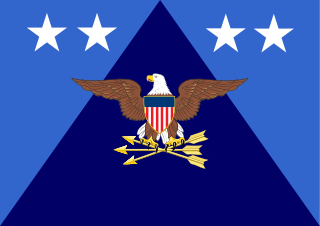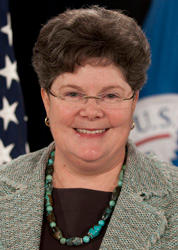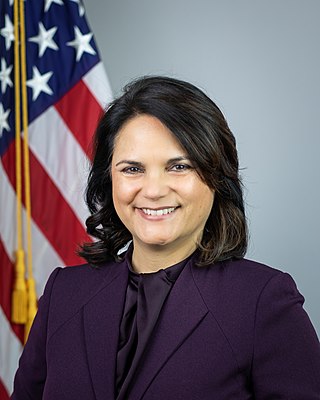
The United States secretary of the treasury is the head of the United States Department of the Treasury, and is the chief financial officer of the federal government of the United States. The secretary of the treasury serves as the principal advisor to the president of the United States on all matters pertaining to economic and fiscal policy. The secretary is, by custom, a member of the Cabinet of the United States and, by law, a member of the National Security Council.

The Office of Management and Budget (OMB) is the largest office within the Executive Office of the President of the United States (EOP). OMB's most prominent function is to produce the president's budget, but it also examines agency programs, policies, and procedures to see whether they comply with the president's policies and coordinates inter-agency policy initiatives.

The Department of the Treasury (USDT) is the national treasury and finance department of the federal government of the United States, where it serves as an executive department. The department oversees the Bureau of Engraving and Printing and the U.S. Mint. These two agencies are responsible for printing all paper currency and coins, while the treasury executes its circulation in the domestic fiscal system. The USDT collects all federal taxes through the Internal Revenue Service; manages U.S. government debt instruments; licenses and supervises banks and thrift institutions; and advises the legislative and executive branches on matters of fiscal policy. The department is administered by the secretary of the treasury, who is a member of the Cabinet. The treasurer of the United States has limited statutory duties, but advises the Secretary on various matters such as coinage and currency production. Signatures of both officials appear on all Federal Reserve notes.

The United States Department of the Interior (DOI) is one of the executive departments of the U.S. federal government headquartered at the Main Interior Building, located at 1849 C Street NW in Washington, D.C. It is responsible for the management and conservation of most federal lands and natural resources, and the administration of programs relating to Native Americans, Alaska Natives, Native Hawaiians, territorial affairs, and insular areas of the United States, as well as programs related to historic preservation. About 75% of federal public land is managed by the department, with most of the remainder managed by the Department of Agriculture's Forest Service. The department was created on March 3, 1849.
The chief financial officer (CFO) is an officer of a company or organization that is assigned the primary responsibility for managing the company's finances, including financial planning, management of financial risks, record-keeping, and financial reporting. In some sectors, the CFO is also responsible for analysis of data. Some CFOs have the title CFOO for chief financial and operating officer. In the majority of countries, finance directors (FD) typically report into the CFO and FD is the level before reaching CFO. The CFO typically reports to the chief executive officer (CEO) and the board of directors and may additionally have a seat on the board. The CFO supervises the finance unit and is the chief financial spokesperson for the organization. The CFO directly assists the chief operating officer (COO) on all business matters relating to budget management, cost–benefit analysis, forecasting needs, and securing of new funding.
The Chief Financial Officers (CFO) Act of 1990 signed into law by President George H. W. Bush on November 15, 1990, is a United States federal law intended to improve the government's financial management, outlining standards of financial performance and disclosure. Among other measures, the Office of Management and Budget (OMB) was given greater authority over federal financial management. For each of 24 federal departments and agencies, the position of chief financial officer was created. In accordance with the CFO Act, each agency or department vests its financial management functions in its chief financial officer. The following is a list of the 24 affected agencies:

The Office of the Secretary of Defense (OSD) is a headquarters-level staff of the United States Department of Defense. It is the principal civilian staff element of the U.S. Secretary of Defense, and it assists the Secretary in carrying out authority, direction and control of the Department of Defense in the exercise of policy development, planning, resource management, fiscal, and program evaluation responsibilities. OSD is the Secretary of Defense's support staff for managing the Department of Defense, and it corresponds to what the Executive Office of the President of the U.S. is to the U.S. president for managing the whole of the Executive branch of the federal government.
Executive Schedule is the system of salaries given to the highest-ranked appointed officials in the executive branch of the U.S. government. The president of the United States appoints individuals to these positions, most with the advice and consent of the United States Senate. They include members of the president's Cabinet, several top-ranking officials of each executive department, the directors of some of the more prominent departmental and independent agencies, and several members of the Executive Office of the President.

The under secretary of defense (comptroller)/chief financial officer, abbreviated USD(C)/CFO, is a high level civilian official in the United States Department of Defense. The Under Secretary of Defense (Comptroller) is the principal staff assistant and adviser to both the Secretary of Defense and the Deputy Secretary of Defense for all budgetary and fiscal matters, including the development and execution of the Defense Department's annual budget.

The deputy secretary of homeland security is the chief operating officer of the United States Department of Homeland Security, with responsibility for managing day-to-day operations. The department has over 208,000 employees and an annual budget of more than $48.5 billion.
The Office of Fiscal Service (OFS) is an agency of the United States federal government in the United States Department of the Treasury. The office is led by the Fiscal Assistant Secretary of the Treasury. The Fiscal Assistant Secretary reports to the United States Secretary of the Treasury through the Under Secretary of the Treasury for Domestic Finance.
The Office of Electricity (OE) is a program office within the United States Department of Energy. The mission of OE is "to lead national efforts to modernize the electric grid; enhance security and reliability of the energy infrastructure; and facilitate recovery from disruptions to energy supply." It does this through the development and implementation of national policy pertaining to electric grid reliability, and through the management of research, development, and demonstration activities for "next generation" electric grid infrastructure technologies.

The Under Secretary of Homeland Security for Management is a high level civilian official in the United States Department of Homeland Security. The Under Secretary, as head of the Management Directorate at DHS, is the principal staff assistant and adviser to both the Secretary of Homeland Security and the Deputy Secretary of Homeland Security for all aspects of DHS administration, finance, and personnel issues.

Caryn Wagner was the Department of Homeland Security’s Under Secretary of Homeland Security for Intelligence and Analysis from February 11, 2010, to December 21, 2012. As such, she was DHS’s Chief Intelligence Officer (CINT), in charge of the DHS Office of Intelligence and Analysis with responsibilities over the DHS component intelligence services. She was the first woman to serve in this position, after extensive experience in the U.S. Intelligence Community and on Capitol Hill.

Nani A. Coloretti is an American policy advisor who is currently serving as the deputy director of the Office of Management and Budget. Coloretti served as United States Deputy Secretary of Housing and Urban Development from 2014 to 2017. Following her service as deputy secretary, she became senior vice president for financial and business strategy and treasurer at the Urban Institute.

David L. Norquist is an American financial management professional and former government official who served as the 34th United States deputy secretary of defense from 2019 to 2021. In May of 2022, Norquist was selected as the President and Chief Executive Officer of the National Defense Industrial Association (NDIA).

The Chief Financial Officer and Assistant Secretary for Administration of the United States Department of Commerce oversees management matters in the Commerce Department, including financial resources, human resources, and facilities. The Assistant Secretary establishes and monitors implementation of Departmental administrative policies, including budget and financial management, strategic planning and performance management, human resources management and civil rights, employee safety and health, procurement, grants management, travel and transportation of household goods, real property and facilities management, directives management, and security. He coordinates implementation of government-wide and Departmental management initiatives. Performance of functions related to the position of Chief Financial Officer are as required per the Chief Financial Officers Act of 1990. The Assistant Secretary is also responsible for the management of the Department of Commerce headquarters in the Herbert C. Hoover Building in Washington, D.C. The office is currently held by Ellen Herbst.

John Euler Whitley is an American government official who served as the acting United States Secretary of the Army from January 20, 2021, to May 28, 2021. He previously serviced as Assistant Secretary of the Army and acting director of cost assessment and program evaluation for the Department of Defense.












